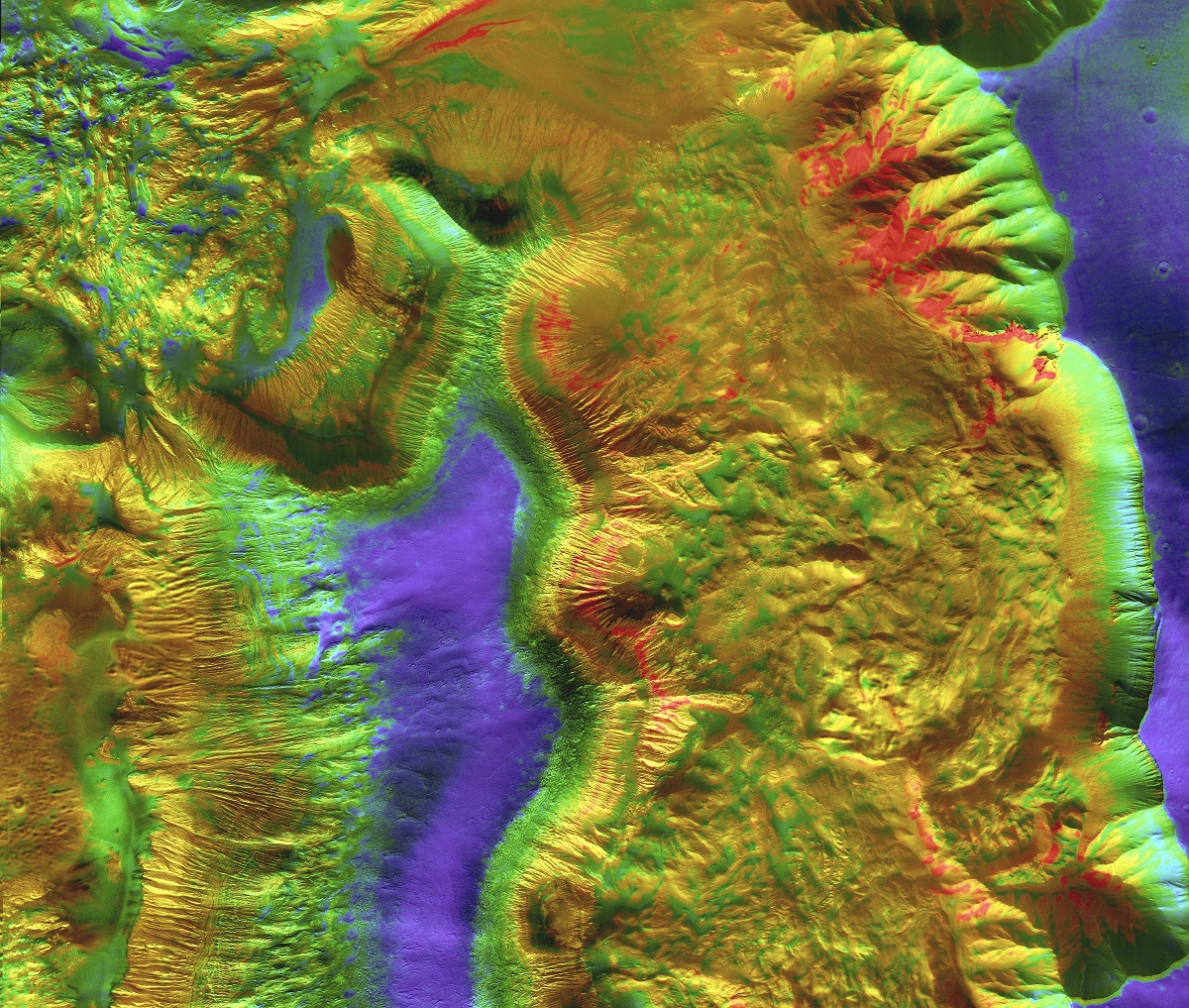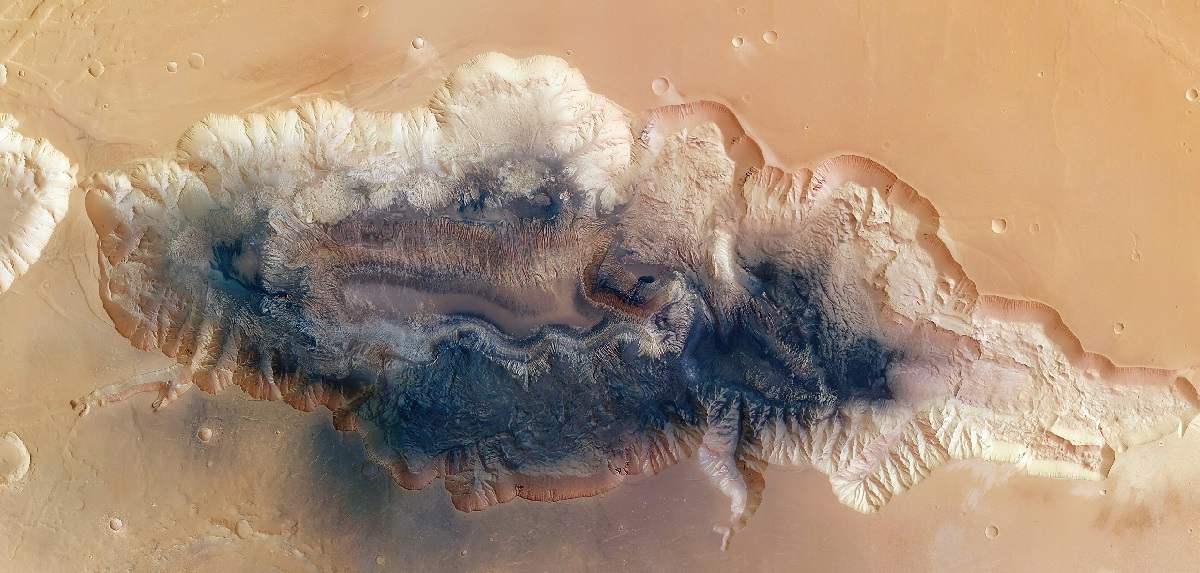Hebes Chasma
Hebes Chasma
We Build Custom 8K Mars Canvas Prints of Hebes Chasma
Hebes Chasma
Hebes Chasma is an enigmatic and fascinating feature on the Martian landscape. It is an isolated depression—a type of canyon—that has been the subject of scientific scrutiny due to its complex geological formations and the tantalizing clues it offers about the Martian environment.
Geographical Location
Hebes Chasma is geographically positioned at about 1°S latitude and 284°E longitude on the Martian surface. It is located in the Tharsis region, which is an expansive volcanic plateau featuring some of the largest volcanoes in the solar system. The chasma sits to the north of the Valles Marineris canyon system, one of the most extensive and deepest canyon networks in our solar system, comparable in length to the distance from California to New York in the United States. Hebes Chasma stretches approximately 315 kilometers in length and about 125 kilometers in width, making it a geological marvel in its own right.
 Hebes Chasma
Hebes Chasma
Interestingly, it is the northernmost of a series of chasmata, or deep, elongated, steep-sided depressions. What sets Hebes Chasma apart from many other Martian valleys or chasms is its geographical isolation—it does not connect to any other valley systems or chasmata. This isolation makes it a prime subject for scientific investigation, particularly to understand geological processes and features that may not be present in interconnected valleys. The chasma’s unique setting may hold key insights into Martian geology that differ fundamentally from those observable in other regions.
Geological Composition
The geological fabric of Hebes Chasma is incredibly diverse and layered, offering a rich tapestry of information about Mars’ history. The canyon walls are particularly revealing, with multiple, distinct strata of rock layers that expose a plethora of mineralogical compositions at different depths. These layers have been studied using spectral analysis techniques that have detected the presence of a wide range of minerals, including sulfates, iron oxides, and a variety of clay minerals such as kaolinite and smectite. Each type of mineral indicates specific environmental conditions under which they were formed, suggesting a complex history that likely involved episodes of both the presence and absence of water. Adding another dimension to this geological complexity is the central mound within the chasma known as Hebes Mensa. This mound features deposits of dark basalts that are volcanic in origin and lighter-toned sedimentary materials. The contrast between these materials suggests multiple episodes of deposition and erosion, hinting at dynamic geological activity over extended Martian epochs.
Significant Discoveries
Layers of History
One of the most awe-inspiring aspects of Hebes Chasma is the exposed rock strata that seem to serve as a geological archive, recording key periods in Martian history. Different layers in the walls of the chasma have displayed varying mineral compositions, which are interpreted as signals for diverse environmental conditions over time. For example, the presence of sulfates usually suggests an acidic and water-rich environment, whereas the presence of certain clays might indicate a more neutral pH and water-rich conditions. This stratigraphy provides an invaluable timeline that helps scientists piece together a complex history of water presence, climatic shifts, and other environmental transformations on Mars.
Central Mound (Hebes Mensa)
The enigmatic central mound known as Hebes Mensa has become a focal point for research and speculation. Some theories propose that this mound is the remnants of a filled lake or perhaps sediment deposits that have been pushed upwards due to underground pressure or tectonic activities. The mound’s complex geological makeup, featuring both basaltic and lighter-toned materials, further complicates our understanding of its origin. Nonetheless, it offers crucial hints and challenges for theories related to both geological and hydrological history, such as lake formation, sedimentary processes, and volcanic activities.
Scientific Missions
Mars Express
The European Space Agency’s Mars Express orbiter has been invaluable in providing detailed scientific data on Hebes Chasma. Employing its High-Resolution Stereo Camera (HRSC), Mars Express has delivered intricate topographic models that have allowed for an unprecedented three-dimensional mapping of the region. These models have enabled scientists to study the chasma’s complex geometry, thereby gaining new insights into the geological processes that led to its formation.
 Hebes Chasma (ESA)
Hebes Chasma (ESA)
Mars Reconnaissance Orbiter
NASA’s Mars Reconnaissance Orbiter (MRO) has also contributed significantly to our understanding of Hebes Chasma. The MRO is equipped with a High-Resolution Imaging Science Experiment (HiRISE) camera, which has provided breathtaking, high-resolution images of the chasma. These images have facilitated a more nuanced and in-depth understanding of various geological features, including the chasma’s cliff walls, sedimentary layers, and erosional patterns.
Geomorphological Features
The geomorphological aspects of Hebes Chasma are incredibly varied, adding another layer to its complexity. Most striking are the layered terrains that adorn the chasma’s canyon walls. These layers are most likely the result of sedimentary deposition, which itself may have been influenced by multiple factors, including wind, water, and volcanic activity. Additionally, there are erosional features like gullies, landslides, and talus cones, all of which provide clues about the past and present erosional processes. The presence of rock formations resembling terrestrial ‘badlands’ is particularly interesting. These badlands-like features, characterized by intricate networks of narrow, steep-walled valleys, further contribute to speculation that the chasma’s history may have involved water-based erosional processes. Other features like rock falls and eroded craters add even more dimensions to this complex Martian landscape.
Hebes Chasma is a unique and complex geological feature on Mars that offers invaluable insights into the planet’s geological history and potential past hydrological conditions. Its isolated location, diverse mineralogical makeup, and intricate geomorphological features make it a significant point of study for future Martian exploration missions. Further studies and missions to Hebes Chasma could potentially unravel more secrets, helping us understand not just the history of Mars, but also shedding light on the broader geological processes that govern planetary evolution.
Check out our 3D Mars Learning Center for more information on Mars and Hebes Chasma. You can also learn more at: NASA Mars Exploration.
More About Mars
Contact us today to learn more about our 3D services and how we can help you achieve your goals.





